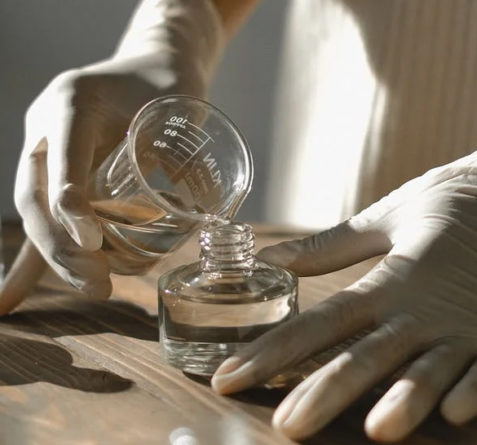ARE PERFUMES BAD FOR YOUR HEALTH AND THE PLANET?
Perfume is a US$27billion industry with strong motivations to sell sell sell, but it is beginning to show its dark underbelly as the world starts to care more about what we put in, and on, our bodies, where it comes from, how it is sourced, and its sustainability in its broadest context.
The perfume story has its origins in nature. Thousands of years ago the ancient Egyptians and Mesopotamians created balms for religious ceremonies and burials using fragrant plants, resins and other natural ingredients. As the extraction of fragrance can involve huge amounts of seasonal or rare ingredients, they became prized and were typically only used by the wealthier ancients.

In the fourteenth century Hungary Water was invented, in Hungary! The novel addition of alcohol to scented oil blends made the water popular, and more affordable. By the eighteenth-century perfumes really took off in France. People were generally suspicious of disease carrying water with inevitable consequences for personal hygiene. These fabulous smelling blends kicked off the industry that we now know, with strong connections to Grasse which had the perfect growing conditions for some of the principal ingredients.
So far so good, but the twentieth century saw a sharp increase in the demand for perfumes and in turn this presented a huge commercial opportunity. To meet this soaring demand, and to ensure that favourite perfumes always smelt the same it was inevitable that it would become a mass manufactured product. Perfumes were now derived not from natural ingredients, but from synthetic ingredients which smelt similar to natural ingredients, or indeed nothing like anything natural but something you might like. On top of that, synthetic perfumes were far cheaper to produce, to the extent that the liquid in the bottle can represent as little as 2% of the cost of the perfume you buy; a little insight into how it has become a $27billion industry.
At the heart of the industry there remain experts – the noses. You can spend many years training as a perfume nose with one of the big fragrance houses, but you will probably only come across natural ingredients in the first year or so. After that you are essentially a chemist, playing with a host of molecules, deconstructed from nature, reconstructed to suit certain demographics, geographic tastes, or the desire to smell like a magic garden on a sunny day. It really has very little to do with nature and much more to do with appeal.

A rose, which can comprise over 200 different molecules, will change its fragrance depending on growing conditions, rainfall, where it is grown and how it is harvested. So not surprisingly when you buy a rose fragrance it is highly unlikely that it has been anywhere near a rose. There are also a host of natural products that are so delicate that the essential oils are super expensive and really not affordable for most of us. Jasmine, Neroli and Rose are three of the most expensive oils or absolutes, and incomparable, in my opinion, with anything made synthetically.
We know it’s not natural, we know we are being hoodwinked by the advertising, but what still remains largely unknown is how harmful perfume is, around 80% of which is alcohol. This is the bit I find intriguing. As a consumer you do not know what is in your perfume, or indeed any fragrance that declares perfume as an ingredient. This is because the industry is allowed to keep this trade secret close to its heart for fear of copycats, but also because the ingredients can be a very long list of chemical combinations with very long names, which will just remind the consumer how unnatural it is.
So, if we don’t know what’s in it how do we know it is safe? There are rules, safety conditions, compliance with cosmetic regulations for what touches the human body. Each perfume is safety assessed based on the long list of chemicals in it to ensure that there is not too much of x, y, or z, which may have been proven to be carcinogenic, hormone disruptive or simply an active allergen. This essentially means that the Department of Health and the Department of the Environment don’t get too involved, calling it a self-regulated industry.
The safety of fragrance chemicals is not determined, monitored or safe-guarded by any governmental agency. Instead, the fragrance industry has been trusted to self-regulate and to establish its own safety guidelines for the use of fragrance chemicals through the International Fragrance Association (IFRA) and its research arm, the Research Institute for Fragrance Materials (RIFM).
 There is an inherent conflict of interest when an industry self-regulates the very products from which it derives profits, exacerbated when the majority of safety studies on fragrance ingredients are unpublished research papers conducted by the major fragrance manufacturers.
There is an inherent conflict of interest when an industry self-regulates the very products from which it derives profits, exacerbated when the majority of safety studies on fragrance ingredients are unpublished research papers conducted by the major fragrance manufacturers.
RIFM’s “independent” Expert Panel is handpicked by the industry and reviews safety data on fragrance ingredients that has been fully compiled and curated by RIFM staff.
So, it’s not easy to connect what you as an individual identify as a health concern when you don’t know what is in a fragrance, and even harder to pinpoint which combinations might be affecting your own personal chemistry.
In the absence of chemical ingredients disclosure by fragrance houses there is little to go on in terms of specific scientific studies, although Prof Anne Steinemann (Phd Stanford) has published various studies on Pubmed.gov including The prevalence of fragrance sensitivity in the American Population which showed a third of the surveyed population has a fragrance sensitivity detrimental to their health, including headaches, breathing difficulties, adverse health effects and skin irritations.
IFRA does publish Standards which implement bans and restrictions on certain fragrance ingredients, but we all have a different chemical make-up, and there are no guarantees that these regulations prevent the Russian roulette of wearing perfume on your skin.
The industry only reacts when certain ingredients are shown to cause harm. Maybe they are scaled back, or maybe banned, but this is quite rare, and utterly misleading as a guide to safety. I was always rubbish at chemistry but the one thing I did learn at school is that combining molecules can change their nature and behaviour. So, if you have multiple ingredients in a perfume, but they are considered individually, clearly there must be risk here. I have been told by people in the industry that it can cost over £2million to do a study on the safety effects of chemical combinations, and that it usually only follows a significant outcry.
So, you may be beginning to see why I am so appalled by the nature of perfume, however fabulous it may smell. This knowledge, and various stories of the drying nature of alcohol on skin, allergic reactions, and the impossibility of wearing perfume on your skin if you suffer a skin condition, has led me to look at alternative ways to smell great without putting an undisclosed chemical concoction on your skin.
So, if you are concerned about the health implications here are my tips for a safe scent experience without ever putting those pesky chemicals on your skin, causing a fit of sneezing, or irritating those around you with over-indulgent spritzing:
- Wear naturally scented jewellery. It doesn’t touch your skin, is alcohol free, and is 100% natural
- Drop some essential oil blends onto a hanky or scarf and wear this instead
- Put some natural essential oil blends onto your COVID facemask. This is one upside that nobody anticipated!
- Use essential oil on your underwear – for your pleasure only perhaps but you will remain fragrant and not ruin your more prized garments
- Wash regularly and just enjoy smelling the flowers.
Smelling wonderful is such a pleasure, for you and those around you, so look after your health by keeping it natural.
 ABOUT THE AUTHOR
ABOUT THE AUTHOR
Kim Brookes is the founder of Perfino, an innovative natural scent jewellery brand. Perfino combines expertly blended, 100% natural, pure essential oils with exquisite jewellery so you can wear scent all day long without any chemicals touching your skin.
 The solid recycled silver and 18ct gold vermeil, artisan designed pendant comes with six lava stones and 10ml of carefully blended natural essential oils – all sourced from sustainable growers. One drop of oil on the stone in the pendant will give you a delicate fragrance that can last for days.
The solid recycled silver and 18ct gold vermeil, artisan designed pendant comes with six lava stones and 10ml of carefully blended natural essential oils – all sourced from sustainable growers. One drop of oil on the stone in the pendant will give you a delicate fragrance that can last for days.
Web: perfino.co.uk
Twitter: @Perfino2
Facebook: perfinouk
Instagram: perfinouk
LinkedIn: kim-brookes

